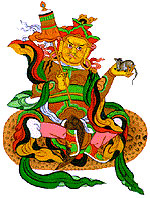
Dai Bishamon-tenno
(Sanskrit Vaisravana) 
Translated as "Great Heavenly King of Knowledge and Wealth" and "Hearer of Many Teachings," Dai Bishamon-tenno is one of the Four Heavenly Kings. He lives halfway down the northern side of Mount Sumeru and protects the north. He is said to always protect the place where the Buddha preaches and to listen keenly to the Buddha's teachings.
Chapters 24 and 25 of the Lotus Sutra state that Bodhisattva Wonderful Voice and Bodhisattva World Voice Perceiver, respectively, can both transform themselves into Dai Bishamon-tenno, in order to expound the Dharma and save others. In Chapter 26 of the Lotus Sutra, Dai Bishamon-tenno compassionately offers dharanis in order to protect those who teach the Lotus Sutra.
Dai Bishamon-tenno protects the place where Buddhism is taught and represents a person with abundant wisdom who gathers information to benefit others. He is known as the wealthiest of the Four Heavenly Kings. He was rewarded with great wealth after years of assiduous practice.
Dai Bishamon-tenno exhorts us to read and travel widely to acquire more knowledge. In the process of learning, we must remember to absorb what is beneficial and discard the rest. The umbrella carried by Dai Bishamon-tenno signifies avoiding distractions and contamination, so that we will not be misled by the deceptive information and false views when seeking knowledge.
The Flammarion Iconographic Guide to Buddhism reads:
"[Dai Bishamon] Vaisravana is the guardian of the north and the chief of the four guardian kings — 'he who is knowing,' 'he who hears everything in the kingdom', the protector of the state par excellence, sometimes thought to be a god of defensive warfare. In China, he is considered to be a Buddhization of the Indian god of wealth, Kuvera, the north being considered to hold fabulous treasures. He presides over winter and is black, so is also called 'the black warrior.' His symbols are a jewel and a serpent, and he commands a large army of Yaksas." (p.242)His Attendants consist of kimnaras and yakshas, who are two of the eight kinds of supernatural beings who are said to revere and protect the Dharma. The kimnaras are celestial musicians and dancers who have the bodies of birds but human heads. The yakshas are flesh-eating demons who make up Dai Bishamon's army. Originally, the yakshas appeared as the spirits of the trees and forests and even villages, but they became fierce, and in their more demonic aspect, came to be called rakshasas.
The Flammarion Iconographic Guide to Buddhism states:
"The Yaksas are commanded by 28 generals, of whom the chief is Pancika — according to the Mahavamsa, he was the father of the 500 sons of Hariti [Kishimojin]. Worshipped very early in India (some of his representations are found in Gandhara and in northern India) as well as in Java, this general of the Yaksas was soon merged with Vaisravana." (pp. 244-245)Appearance: Dai Bishamon-tenno is often depicted as yellow and bright as a thousand suns. In his right hand he holds an umbrella; in his left hand, a jewel-spitting mongoose, which may provide sentient beings with inexhaustible wealth. Because his breath is deadly, he always sits with his mouth shut.
Choose another
of the Four Heavenly Kings: Dai
Jikoku Tenno, Dai
Zojo Tenno, Dai
Komoku Tenno.